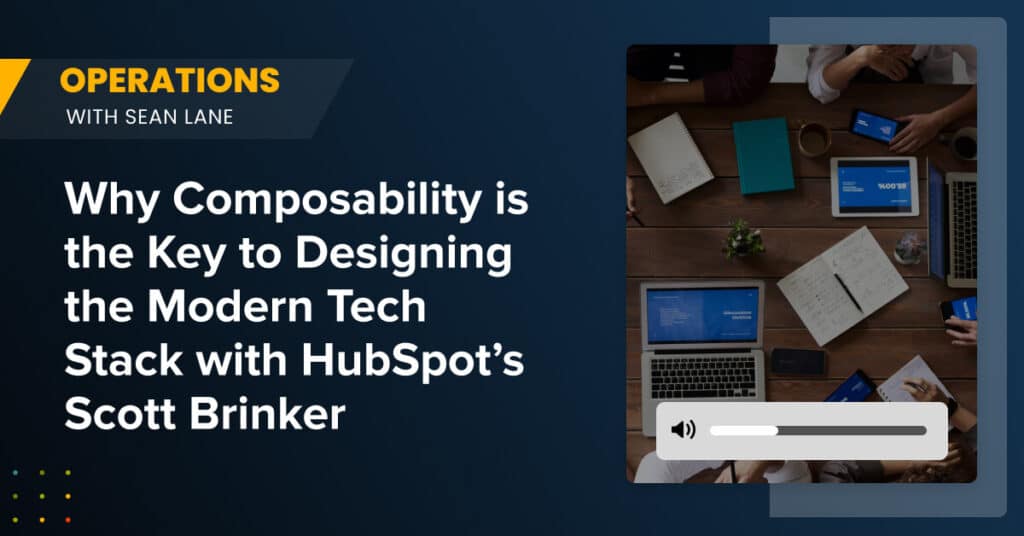Optimizing Sales Strategy & Ops Investments in a Fast-Growing Company – Account Scoring and TAM
Overview
- When is it the right time to start account scoring? [3:18]
- How do sales teams feel about account scoring? [5:32]
- When it comes to account scoring, how do you address the build vs. buy question? Also, how do you demonstrate the ROI? [7:51]
- What type of manual data input should be involved in account scoring? [14:11]
- When is the time to move from account scoring to TAM? [15:54]
- Where do you get the data for a TAM exercise? [18:26]
- What have been some outcomes of TAM analysis that you’ve seen? [21:59]
- How do you approach data enrichment for specific industries? [24:15]
- How do you approach refining your team, including getting budget for various roles? [26:21]
- Final thoughts [28:38]
Introductions
Ashley
Thank you, everyone, for coming to our Fireside chat today. Our topic is how to optimize sales strategy and Ops investments in a fast growing company. And we have two guests with us today, Eric Portugal-Welsh and Doug Jensen. I’ll start by letting them do their quick introductions. And for that, we’ll have them tell us their name, their current role, what they do, and a quick, tiny tidbit on their interpretation of what Rev Ops means. Eric, would you like to get us started?
Eric
Sure. Hey, everyone. Eric Portugal, Welsh here. I’m the director of revenue operations at a startup called Demostack. My interpretation of Rev Ops really kind of boils down to full funnel visibility. So tracking the operational excellence from marketing sales and all the way through to customer success. So I think of the funnel as a bow tie if you follow Winning by Design’s framework. And so it’s basically operational excellence through the entire bow tie funnel.
Ashley
Awesome. Thank you, Eric. And Doug.
Doug
Yeah. Hey, everyone. I’m Doug Jensen. I head up sales for Pattern. At Pattern, we consider ourselves an e-commerce accelerator, so we help brands take their products to marketplaces globally. So think Amazon, think TMall in China, Coupang in South Korea and so forth. And I would consider Rev Ops definition probably similar to Eric. But I might add that Rev Ops is kind of the glue, at least for my sales org, that brings everything together. It makes sure that my team spends their time very efficiently. And what I mean by that is: Which accounts did you spend time? On which personas in those accounts should you spend time with? Do you have a data-driven sales strategy? And Rev Ops can support a lot of that heavy lifting. And as a salesperson, I know sales people are horrible with data, generally speaking. And anything they send me in Excel, I don’t trust and Rev Ops solves all of that for me. So that’s kind of where my head is on Rev Ops function.
Tyler
Rev Ops is just as bad a data, so it’s fine.
Doug
Trust me, not just as bad.
Ashley
Awesome. Thank you both. All right. I’m going to hand it over to Tyler to take it from here.
Tyler
All right. Hi, everybody. My name is Tyler. I run Customer Success at Fullcast, and as you know, we are a go to market planning software, so I will be moderating this discussion. And I think today we’re going to talk about some interesting things as it relates to account scoring, TAM, as well as maybe dive into some of the industry-specific data enrichment stuff; that when we’re starting to think about what we want to get into a vertical – where do we go? when’s the timing right for that? And then if we have a little bit of time left, we will talk about structuring Rev Ops teams, including what that looks like at each kind of stage of maturity as a company grows.
When is it the right time to start account scoring? [3:18]
Tyler
What I think is a really good starting point is to talk about timing with account scoring. When is it the right time to start account scoring? Because I feel like at some point it’s almost too early to dive into starting to build your account score – maybe because there’s not enough data. And then there’s probably a time where it’s too late because then you’re overwhelmed. So I’m just curious to hear, let’s start with Eric. From your perspective, when you think about account scoring, what is that right timing as to when should people start to think about building out an account score?
Eric
Yeah. Well, I think it’s never too early to think about building the structure to allow for account scoring. So if I could just take a step back really quick and go a little more tactical here, when you think about building out your CRM and your account structure, it’s important to understand where you might be in a year or two years from now. So we are currently in the process of building out an account based structure in Salesforce, which means building out a lead routing process that converts everything to a contact and account.
So you understand the total number of contacts you have, the lead scores that they have, and how it associates to the account. So it’s never too early to do that. And that sets you up, when you’re ready to start account scoring, so that you have all the structure in place to do it. I would say you probably need a handful of customers, at least, in order to start doing this, probably somewhere in the neighborhood of, like, 30 to 50. So you understand what those customers look like and what attributes can be assigned to them, to their score, that’s kind of the bare bones of it.
I think scoring is interesting in that, you can start and then just keep iterating on it. It’s not an exact science. It’s more of an art, I think, in my opinion, as long as you have some sort of customer data that you can pipe back into your system and kind of use to analyze and figure out what makes a good account a good account, then you can start scoring that way as well.
How do sales teams feel about account scoring? [5:32]
Tyler
Yeah. From your perspective on the sales side, Doug, I always wondered whether salespeople ever get excited about having an account score on the account. Let’s say your account score is zero to 100, and they’re like, I’m stoked to have this [account] because I can look at this and go, this is 80. This is probably going to be a good company to go after. So I’m going to target this first and then the ones that are down at ten, not even to worry about until I’m, like, dry and I got nothing else to do.
Doug
I think salespeople are like big, dumb animals. I’m just joking. I can call myself that. My thought is we’ve done scoring for a number of years, and there’s a couple of things. Generally speaking, this isn’t everyone. But generally speaking, sales people expect the scoring to be perfect. And so I think you have to help them with their expectations setting you’re, like, just help them understand that scoring is all data driven. The data comes from different sources. You’re reliant on those sources, and there’s no data source from a sales perspective, prospecting, technographic, whatever database you’re looking at, that’s perfect.
So I think that’s number one with me for the sales team just to help them understand that. Listen, back in the day, you used to spend hours and hours and hours just trying to figure out who to call. This is really just taking 80% of your work and pointing you in the right direction. It takes 80% of that work away. So my thought was it is they do pay attention to it, but they inherently don’t trust it. And that’s usually because the data is never perfect, but it’s never going to be perfect.
So I think for me, it’s always: help them understand what they’re working with and help them see the bright side of this. The glass is like 80% full here, 80% of your minutia was taken away from you and point you in the right direction. And I think as they start to get their head around that, then they’re more appreciative and more trusting, and then they lean in and become more collaborative. Right? They can help refine the data sets, help refine the scoring approach and so forth.
But you kind of have to convert them into partners in the process rather than just expect them to take the number and run with it.
When it comes to account scoring, how do you address the build vs. buy question? Also, how do you demonstrate the ROI? [7:51]
Tyler
Yeah. This is an interesting point, because the last one of these that we did, we actually talked about feedback loops, probably a lot. And I’m just hearing you talk about it again, which is just having sales feed that back into revolts. So they know where to make those tweaks to the scoring. There’s tools out there that do this. But I’m also feeling like a lot of companies can do this themselves. So I’m curious if there’s ever a discussion around, like, build versus buy, and if there is what are some of the things that you might think about with that?
Eric
For me, it’s all about bandwidth of the team. Right. So buy is always the solution when you’re early stage and you don’t have enough people or expertise to build out a model like this. In my company’s current phase, like, we don’t have an analytics team or data science team or people who can build out account scoring like a sophisticated account scoring model. So I would buy a tool that would do it for me. I’m also building out the integration for every system that we have that touches the Rev Ops team.
So managing 15 systems and a sales team and all the analytics around that there’s no time to build this. So the buy argument is pretty strong for me. And if it’s something that company does and specializes in and allows me the flexibility to change inputs, but I don’t actually have to maintain, that’s a pretty easy argument there as well.
Tyler
Wonderful. What about you on your side, Doug? Do you see anything there? Do you have anything to add?
Doug
Yeah. I think you have to license data. You’ve got to find data. And then my experience has been on the data side – I’ll stay there for a second. Typically the TAM you’re building out and the accounts you’re going after. You also typically need to augment the data you license with some manual entry. And I think sometimes we get to, like, an AI – everything’s automated world in our mind. And that’s not always the case. Sometimes the most valuable data points you’re going to get do need to be human entry.
I would say keep an open mind on that. And then on the tech side of how to make use of the data, there’s awesome tools out there. So, if you can speed yourself up, it’s pretty easy to justify, right. Especially on the sales side here, if I can speed this up three months, how many additional brands does that mean? How many additional partners does that mean? Or customers? So that’s one of the fun parts about being on the sales side. It’s very easy to justify more budget because you’re getting more revenue.
Tyler
Have you ever actually been able to really measure ROI? Because it’s hard to measure that. That’s kind of disagreeing with you. But I’m going to come full circle with that. So I think that with revenue, there’s so many inputs, right. And how do you narrow it down to being like, okay, well, I bought this tool or I’m investing in this thing. I know that this lever that I’ve pulled here with this account scoring stuff has actually contributed X amount to revenue or has contributed X amount to productivity.
Have either of you put something together where you’ve been able to actually measure that specific piece? And what would that look like?
Eric
I’m curious, Doug, what you have to say on this? I’ve got a few opinions.
Doug
Yeah. My experience with it has been every business I’ve joined has something working. There’s some channel that works. And is that marketing? Is that referral partners? Is that whatever it is? And so this targeted outbound is kind of a new channel that you can add to the mix. So if you say, all right, we’re driving 20% from dot com inbounds, web form fills, whatever; 30% from referral partners; 30% from upsells. It’s almost like you can add on a new channel, new tranche. But then also getting more targeted makes the others more effective, if your advertising dollars are going towards accounts that are 50% better. Those are a little harder to measure, but I like to think of it as almost another channel that’s incremental to the business, and that makes the others more efficient.
Eric
I think when we go into this topic, you got to look at sales tech from each different level or each different type of sales tech. In my experience, the easiest ones to get budget for are enrichment or prospecting tools. Those are very clear ROI. I source these five deals from Zoom Info, and we’ve gotten 200% ROI on it just from those five deals. Like, you could buy enrichment and prospecting tools all day long, as long as they’ve got some use out of them. It gets a little more complicated when you kind of go a little further down the funnel and you’re talking about engagement tools and contracting and CPQ stuff like that.
But at the end of the day, if they’re creating any sort of productivity enhancements for the team, they’re worth it. And it’s, in my experience, relatively easy to get budget approval for this.
Doug
Yeah. I think that’s a good point. Maybe. Eric, I’d just add to that: the source, the opportunity source or lead source is a good way to do it. We call our outbound kind of targeted that we call it Project Ten X. Our thing was like, let’s ten X the business through these efforts. And so that’s the source for all opportunities that are created by this program. And so you can easily go measure how many close deals have a source of Ten X. In that case, that’s a good way to think about it.
What type of manual data input should be involved in account scoring? [14:11]
Tyler
Right. So we’re halfway through our 30 minutes and we’re still talking about account scoring, and I’m dying to know I got to get a quick hit in. So, Doug, you talked about some of the manual data inputs here, so real, like, super quick. What are some of those things that you’ve seen is like manual data inputs that you thought were key that would be brought into, like, an account score or something like that.
Doug
Yeah, for me, it has depended. I’ve run a couple of different teams, and so it depends on the value prop of the business. And so in our current business, we approach brands that have physical products they want to sell on digital marketplaces. And a big data point for us is their selling strategy. Do they sell themselves on Amazon? Do they have a third party that sells for them? Do they sell directly to Amazon? So just depending on their seller strategy, there are six different seller strategies that we identify.
We can automate discovery of five, but the 6th one requires a manual entry, so we can find if they sell for themselves or if someone sells for them. But it’s convoluted in our data. So we have a contractor go through and pill out the ones that have a different third party selling for them. My answer would just be it’s usually a custom thing that a third party is not going to have. And that’s okay. And that’s kind of my comment just maybe keep an open mind to manual data augmentation is probably something you’re going to need, and that’s fine. It’s totally fine to do, but that’s an example one.
When is the time to move from account scoring to TAM? [15:54]
Tyler
Okay. Let’s move on to TAM. So I’m curious from Eric’s perspective, I’ve always thought about TAM as this next level in maturity from account scoring. And what I’ve seen a lot of times there’s, like, kind of two ways to think about this. It’s like TAM is the global view of what is my total addressable market. And then we’re starting to see more people stamp a TAM number or a current, like a dollar value on an account saying this is the TAM of this account and then being able to build their whole world from that.
So, circling back to maturity. Is is like “I did this account scoring with 30 to 50 customers. Now I’ve got a bunch more. And now I’m going to start thinking about TAM.” I’m curious from your perspective, what are the differences between the two and what might you see as being the sign that it’s time to move onto TAM. And feel free to disagree with me if you think TAM should be done earlier on, and that it’s not a later stage thing.
Eric
Yeah. So I’ve not done the stamping a TAM number on to a specific account, so I can’t really speak to that. I’ve kind of been more involved with just building out the total addressable market in general, the global sense. You need to understand your ICP first, right. In order to get a sense of what’s out there, who you should be selling to. You need to have a pretty clear understanding of who is going to be using your solution, who’s going to be using your product?
And I’m having a little past trauma from doing this at my previous company, where the ICP is very difficult to find using any sort of, like, globally available data enrichment tool or prospecting system. So building out a list of accounts that met a very unique criteria to sell into was extremely challenging. Like no industry type, subtype, zip code, NAICS code. Anything that you would typically use to find, like, what these companies actually do was at all useful when we built this out. So we had to use third party vendors and data enrichment services service providers to actually go into websites and find what they would do and build out a list of accounts for us. And then we could extrapolate from there. But I probably missed the prompt on the overall question going down this rabbit hole.
Where do you get the data for a TAM exercise? [18:26]
Tyler
No, actually, I think that was super interesting because I think that ties into also just trying to understand, where do you get this information from, do you just pull it out of the CRM? Do you get it from third party vendors? Do you go get it manually? And it’s kind of almost a conversation we’ve been having with account scoring to model this stuff out.
Eric
In doing that project, that TAM project, we used a certain data enrichment tool and had to validate everything with these data service providers, contractors, and whatnot. And we found that that tool, that enrichment source, like their data just on B2B versus B2C companies was way off, like, it just led me to really distrust enrichment data more than not.
Tyler
In this past life trauma, were you doing the TAM analysis in the CRM? Like, you were pushing data into the CRM, and you’re like, okay, here’s our world of accounts. And so based off of this, this is TAM, or were you doing this somewhere else?
Eric
Yeah. So we had a couple hundred thousand legacy accounts in our CRM, so we ran it basically off of that. And then we looked at what else was out there in this enrichment database and kind of matched. We looked at our current customer profiles, saw what the data enrichment was telling us about them, and then ran models against it. But a lot of the companies that met those, criteria did not actually meet our ICP at all because they weren’t actually the same kind of companies that this enrichment source was telling us they were. We were selling to companies that either provided websites or built websites. And that’s a very difficult thing to find online.
Tyler
Which has been your experience, Doug, in the TAM world?
Doug
Yeah. Generally, I like TAM, and I think your comment, Tyler,? Earlier that it does feel like kind of a more mature thing for businesses to be thinking about. And it can be really strategic going beyond just sales and marketing efforts. Right. What’s the total opportunity for the business? Should product teams think about creating more items or different items, because the TAM is too narrow? There’s all kinds of implications.
To Eric’s point, the TAM really should be a data set. In its simplest form, it’s a database. And whatever your business needs to get your database to a good state, do that. And then can you weight and prioritize things effectively in there? Then that helps you go to market. But, yeah, I don’t know. I like to simplify it as a database. Maybe it’s an Excel file with five columns and whatever. But just think about it simply. You have got a database and that’s a proprietary asset of the business. So build it, maintain it. It should grow over time. Think of ways to enrich it and think of ways to stratify that, so you’re prioritizing the most important accounts in there.
What have been some outcomes of TAM analysis that you’ve seen? [21:59]
Tyler
Do you have an example of doing a TAM analysis which informed some kind of specific go to market change that yielded results? I’m just going to put you on the spot with that one. I’m just curious.
Doug
Yeah. I mean, in my current business, we’ve tripled the sales team because we know the TAM is large, it’s massive. And so we went to the board, and two weeks ago, they approved substantial additional budget to fund growth because we’re saying we have X number of reps. They can only get to X number of accounts. That’s 15% of our market. So are we going to play to win or what are we going to do here? Those have been some of the changes.
In a previous life, I could see the TAM was much smaller than our board thought, and that caused actually a lot of friction. So as a sales leader, I had to delicately deliver the message and people didn’t want to hear it. It turns out to be right four years post that the TAM data is something you can trust and rely on. And you should know that, right. Especially if you’re on the go to market for the house. You should know what the market opportunity is.
Tyler
Yeah. Do either of you have any experience from the TAM exercise of finding an industry that you felt was like, well, we need to be doubling down on this because it’s huge in this industry?
Eric
I’ve actually recently found pretty much exactly what Doug was just talking about, that the TAM was much smaller than the senior leadership in the board originally thought and that we were focusing on the wrong part of the business. We were trying to open up this new segment, and people were thinking there was a lot of upside there, and there really wasn’t. So we then refocused and doubled down our efforts on the previous, kind of, bread and butter of the business. It took resources away from this new segment, but adding them to the bread and butter segment really increased revenue there.
How do you approach data enrichment for specific industries? [24:15]
Awesome. We’ve got this on this list [of questions] here. It’s industry specific data enrichment. So I think the way I would want to just understand from both of your experiences is just, where have we gone down a HLS or finance vertical and knowing that you need to go get other data, and what was the process or the framework you used to go and find it outside of maybe like DNB and Zoom Info, the big names you already know. And maybe it was nothing. Maybe you just like Zoom Info.
Doug
I’ve always just gone different data providers, like a Mix Rank or HD Data or whatever. And my opinion on it is no one has a complete data set. And so I think naively, some people go in and, like, Zoom Info has got data that says they use X technology, but that’s almost never going to be completely accurate. So I think that’s part of the practice here is getting good at data handling. So you’re going to take data from multiple systems. You’re going to port it together into your database, back to that simple Excel file database idea.
And you’ve got to be able to be really good at porting data back and forth. And we use that 18 character Salesforce account ID as our unique character, unique value. And that’s also a place that sometimes you have contractors help you manually match things up. But I usually go look at different data providers. And typically my experience has been each of the data providers is really good at something and definitely not good at everything. So you’re probably going to look at multiple and test and learn a little bit and you’ll figure out the ones that make the most sense for your business.
Eric
Yeah. I don’t have much to add there. I approach it pretty much the same way.
How do you approach refining your team, including getting budget for various roles? [26:21]
Tyler
Great. All right. So we have three minutes left. We can choose another fire round if we want to call it that, because I do want to leave some time if you guys want to have any parting thoughts for the audience. But we can do a fire round on this refining roles and teaming, which I feel like is like another 30 minutes in itself. But what do you think, Eric? Doug, do you want to take this on? 1 minute each on the clock to talk about what I’m feeling like we should just sum it up. I don’t know.
Eric
I’ll fire this one over to Doug. It’s really easy to justify new sales hires. It’s really hard to justify new Ops hires.
Doug
Atually, my take on that, Eric, is really that we under invest in Ops all across the board. Usually salespeople are not cheap, right? They’re coin-operated people and you want that, but it’s also more expensive. So do you want them to be efficient or do you want them to be digging through ZoomInfo looking for an email address? Because that’s what they’re doing. I think the Ops roles are, I think they’re much easier to justify because for me, this is an efficiency plan and they’re expensive resources.
And the data and the tech also, for me, have been pretty straightforward to justify. The other thing I’m always willing to do, I’m like, I’ll take on more quota. So give me an extra million dollars in quota. And here’s what I need. And basically, no one says no to that.
Eric
Yeah. I’m also in a unique position right now where our sales leader felt the same way as you did, Doug, and hired Rev Ops really early, like, way before most companies would see the need. So it’s a really exciting position to be in. We’re solving problems before they even exist.
Tyler
What’s early?
Eric
Three sellers.
Tyler
Okay.
Eric
The earliest I’ve come in before is about 15 sellers.
Tyler
Yeah. I feel like that’s almost crazy late and if you were the first one at 15 sellers, you’d have a lot of clean up to do.
Final thoughts [28:38]
Tyler
All right, if there’s any parting thoughts that you want to have for the audience, feel free to sum up our wonderful conversation, and we’ll start with Doug, and then we’ll let Ashley take us on out.
Doug
Yeah. I appreciate your time. This stuff is fun. I think this is fun. So if you don’t think it’s fun, find someone that does. But I think this stuff is fun, because if you’re mentally engaged in this, you can definitely move the needle for the business. So maybe that’s my parting word of advice. I think it’s fun. So if you dig in, probably enjoy it. But if you don’t find someone that does enjoy it because it’s worth it to the business.
Tyler
Yeah.
Eric
Eric, yeah. I’d agree with that. I think the collaboration between operations and sales is a really exciting place to be in. Fora Rev Ops person, getting to touch different parts of the business is also just really exciting. You get to see the impact through the entire customer journey. So, yeah.
Tyler
I agree with that. I jumped in about four plus years ago, and I’ve never looked back. It’s an absolutely great place to be. Ashley, take us away.
Ashley
Thank you all for coming, Eric and Doug. Thank you so much for giving us your time. And we will share out the recording link and all that stuff with our folks who spend their time with us today. I didn’t see any questions in the chat, so I’m going to take that to me. And nobody had any pressing things that they wanted to ask, Eric or Doug. But thanks again for coming and everybody have a great day.
Tyler
Thank you. Bye.










